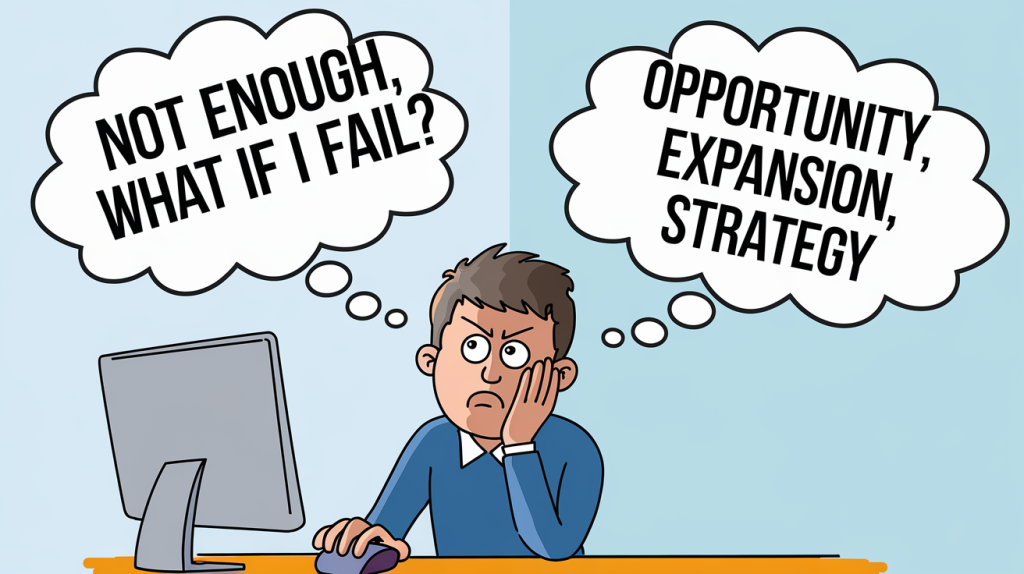The Hidden Mindsets That Keep Creatives Broke (and Overwhelmed)
This post contains affiliate links. Which means we may receive a commission for any purchases made through our links. As an Amazon Associate, I earn from qualifying purchases. See our full policy. Thank you for reading this post. Don't forget to subscribe!
Have you ever bought a shiny new course, grabbed a stack of PLR templates, or downloaded freebies from every corner of the internet only to let them collect digital dust on your hard drive?
Or maybe you’ve found yourself pricing your products so low, you’re practically giving them away, just to “make sales.”
If that sounds familiar, you’re not alone. So many small business owners and creatives fall into what I call the cycle of gluttony and poverty thinking.
On the surface, these two sound like opposites. One’s about having too much, the other’s about not having enough. But in business, they actually feed into each other, keeping us stuck, overwhelmed, and underpaid.
The good news? Once you see the pattern, you can break free.
Here’s the truth: breaking this cycle isn’t about hustling harder, buying more tools, or working longer hours. It’s about shifting your mindset and taking intentional action with what you already have.
That’s why I created a free worksheet just for small business owners and creatives like you:
Breaking Free from Gluttony & Poverty in Business: A Self-Check & Reset Tool
Inside, you’ll find:
- A quick self-assessment checklist to spot where gluttony or poverty mindsets might be showing up in your business
- Simple reflection prompts to reset your thinking
- Practical action steps to help you move from “never enough” into clarity and freedom
This worksheet will help you stop the cycle of over-consuming and undervaluing, so you can focus on growing a business you love, one that pays you fairly and lets you thrive.
What is Business Gluttony?
In everyday life, gluttony usually makes us think of overeating. But in business, gluttony shows up as over-consuming without satisfaction.
For entrepreneurs and creatives, it often looks like this:
- Buying every new course, PLR pack, or Canva template that pops up in your feed… but never actually using them.
- Creating 10 different product drafts, but never publishing or finishing them.
- Pricing your work super low because you want “more” sales, even though those sales don’t really sustain you.
At its core, business gluttony says: “What I have isn’t enough. I need more before I can succeed.”
The problem? Chasing “more” drains your time, money, and focus, leaving you stuck with half-finished projects and digital clutter.

What is the Spirit of Poverty in Business?
On the other side of the spectrum, we have what I call the spirit of poverty in business. This is the mindset that whispers: “There will never be enough.”
It can sneak in through things like:
- Undervaluing your work: Setting your prices low because you’re afraid no one will buy otherwise.
- Scarcity thinking: Believing you don’t have enough tools, skills, or time to move forward.
- Comparison trap: Looking at other sellers or creators and deciding you’ll never measure up.
Where gluttony wastes resources, poverty thinking paralyzes you from using what you already have. Both keep you from growing in confidence and profitability.
How They Work Together (The Cycle)
Here’s the tricky part: gluttony and poverty thinking often feed each other in business.
- Gluttony → Poverty: When you buy more than you can use or create without finishing, you waste resources. That waste leads to the very scarcity that poverty thinking thrives on.
- Poverty → Gluttony: When you believe you don’t have enough, you try to fill the gap by grabbing “just one more” course, template, or freebie. That cycle keeps spinning.
It’s like being on a hamster wheel; working, buying, creating, doubting, yet never really moving forward.
But here’s the truth: breaking the cycle isn’t about working harder. It’s about shifting your mindset, simplifying your actions, and building confidence with what you already have.
The Way Out (Breaking the Cycle)
The good news is you don’t have to stay stuck in the cycle of gluttony and poverty thinking. You can break free with a few intentional mindset shifts and small, practical steps.
Here are three ways to start:
Adopt the “One Thing at a Time” Rule
Instead of piling on new courses or templates, commit to fully using just one resource before moving on to another.
- Bought a PLR pack? Customize it and list the product in your shop before purchasing the next one. Join my 5-day challenge to help you start listing products more consistently in your shop.
- Downloaded a freebie template? Use it in your business this week instead of letting it sit in your downloads folder.
This simple rule shifts you from hoarding to action.
Reframe Your Pricing
If you’ve been pricing low out of fear, pause and ask:
- What value does this product bring to my customer’s life or business?
- What’s a fair exchange for the time, skill, and creativity I put into it?
Raising your price even slightly can break the poverty mindset by reminding you and your customers that your work has real worth.
Practice Gratitude + Generosity
Both gluttony and poverty come from fear: fear of not having enough, fear of not being enough. Gratitude and generosity are powerful ways to fight back.
- Start a simple weekly gratitude practice: write down one tool, one product, and one customer win you’re thankful for.
- Give generously, but with boundaries. Offer a valuable freebie (like a checklist or mini-template) that helps your audience without draining you.
Gratitude breaks the “never enough” cycle. Generosity proves there’s always more to share.
Breaking free isn’t about working harder; it’s about working smarter, valuing yourself, and building from a place of contentment instead of fear.
And if you’d like help walking through this process step-by-step, I’ve created a free worksheet just for you:
Breaking Free from Gluttony & Poverty in Business: A Self-Check & Reset Tool.
Inside, you’ll find a checklist and action steps to put this into practice right away.
Tap Into the Power of AI
Recognizing that a poverty or gluttony mindset is influencing your business is a powerful first step, but turning that awareness into action can be the hardest part.
When you're stuck in your own head, it’s tough to break free from old thought patterns. That’s where a powerful and perhaps unexpected tool comes in: Artificial Intelligence (AI).
By using carefully crafted prompts, you can transform any AI chatbot into your personal mindset coach, an unbiased strategist ready to help you challenge limiting beliefs and discover new possibilities.
To help you get started, I’ve designed a series of copy-and-paste prompts to help you move from reflection into confident action today.
Mindset Prompts to Use in Your Favorite AI Tool
Simply copy and paste your desired prompt into your favorite AI tool such as ChatGPT, Claude, or Gemini.
To Uncover Hidden Scarcity Beliefs:
Act as a business mindset coach. My business is a [describe your business, e.g., graphic design studio for wellness brands]. I consistently find myself [describe a poverty mindset behavior, e.g., giving discounts to every client who asks]. I think my underlying fear is [describe fear, e.g., that I won't get another client if I say no]. Help me unpack this. What are 5 limiting beliefs that might be causing this behavior, and what is a more empowering belief I can replace each one with?
To Define What “Enough” Actually Is:
I am a [e.g., freelance writer] who is stuck in a ‘gluttony' cycle of always chasing more revenue and more clients, leading to burnout. My current revenue is [e.g., $X per month]. Help me brainstorm what ‘Sufficient Success' could look like for my business this quarter. Define it not just by money, but by three other key metrics: creative fulfillment, client quality, and personal free time. Present this as a simple dashboard.
To Tame “Shiny Object Syndrome” (Countering Gluttony Mindset):
Act as a business strategist. I am a small business owner with too many ideas and not enough focus. My primary business goal is [state your main goal]. Here are three new ideas I'm considering pursuing:
- [Idea 1, e.g., Start a podcast]
- [Idea 2, e.g., Launch a digital course]
- [Idea 3, e.g., Create a new service package] Help me create a simple decision-making matrix to score each idea based on its alignment with my primary goal, potential revenue, time commitment, and personal energy. Based on the matrix, recommend which ONE I should focus on for the next 90 days, and which two I should intentionally shelve.
The key to a great AI response is a great prompt. Be as specific as possible about your business, your feelings, and your goals to get the most insightful and helpful results.
You might also like these AI Prompts for Your Business.
Additional Resources
How Coaches Can Create Lead Magnets Faster Using AI
Healing Your Inner Child's Money Mindset
Enjoyed this post? Share it by pinning one of the images below.









